Japan Wood Products
Prices
Dollar Exchange Rates of
25th September 2015
Japan Yen 120.59
Reports From Japan
More stimulus likely as consumer prices fall
Consumer prices in Japan fell in August marking the first
decline since the Bank of Japan (BoJ) began its economic
stimulus efforts two years ago. This data comes at a time
when other indicators suggest the BoJ efforts have been
undermined by falling oil prices and the slowdown in
exports especially to China.
On the face of it more quantitative easing appears likely
but some in the Cabinet are reluctant to approve further
stimulus as this could drive the yen lower against the US
dollar and add to the problems of small companies which
rely on imported raw materials.
New housing policy being developed
A panel at the Land, Infrastructure, Transport and Tourism
Ministry is working to revise the Basic Housing Plan —
which sets the direction of housing policies for the next 10
years to take account the decline in the nation‘s
population, the pace of which will accelerate in the 2020s.
Unless the supply of new houses is adjusted, the problem
of vacant houses will no doubt become even more serious.
A recent estimate by Nomura Research Institute shows
that the number of vacant houses could reach 13.9 million
in 2023.
Previous housing policies have encouraged construction of
new houses and investment in housing accounts for around
4% of GDP. Building some new houses will be necessary
to replace old structures but a continuation of policies that
spur house building will eventually exacerbate the vacant
housing problem in Japan.
August housing starts followed the trend for the past six
months by rising against levels in the same period last
year.
Housing starts increased nearly 9% in August compared to
August 2014. The August figure lifts projections of
annual starts to 931,000. Despite the positive picture on
starts, the level of orders for new construction received by
the largest house builders dropped sharply in August.
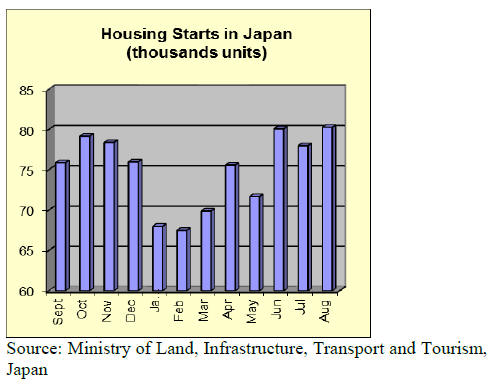
Tankan survey for September
The results of the latest business survey (Tankan) shows
that confidence amongst both large and small Japanese
manufacturers turned negative for the first time in three
quarters. Analysts are now forecasting another round of
monetary easing will be announced by the Bank of Japan.
For the full data see:
https://www.boj.or.jp/en/statistics/tk/gaiyo/2011/index.ht
m/
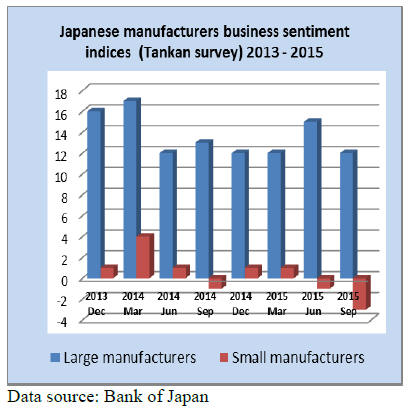
Japan at centre of TPP talks
Negotiations on the Trans-Pacific Partnership (TPP)
continue with both the US and Japanese governments
determined to reach an accord. The TPP if agreement can
be reached will create the world‘s largest free-trade pact.
Negotiating countries include: Australia, Brunei, Canada,
Chile, Japan, Malaysia, Mexico, New Zealand, Peru,
Singapore, the United States and Vietnam which together
account for about 40% of global trade.
The Peterson Institute for International Economics in the
US has estimated that over the next decade the TPP could
add almost US$300 billion in annual global trade with SE
Asian countries participating in the negotiations set to
benefit hugely as tariffs on their exports , including those
on wood products, are dismantled.
Yen strength of concern to exporters
In late September the yen strengthened against major
currencies drive higher by concerns that slowing Chinese
growth will ripple through the global economy. The
strengthening of the yen was also affected by dealers
buying yen as a safe-haven in the current unsettled
situation.
The firming yen is not good news for Japanese exporters
and analysts foresee further upward pressure on the yen.
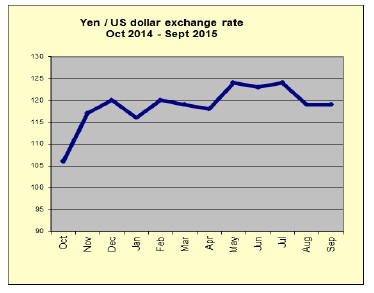
Japan’s furniture imports
Japan‘s imports of office, Kitchen and bedroom furniture
fell in August. Office furniture imports have shown a
steady decline since the beginning of the year.
The dip in kitchen and bedroom furniture came as a
surprise as housing starts, while weakening, have not
shown a sharp decline.
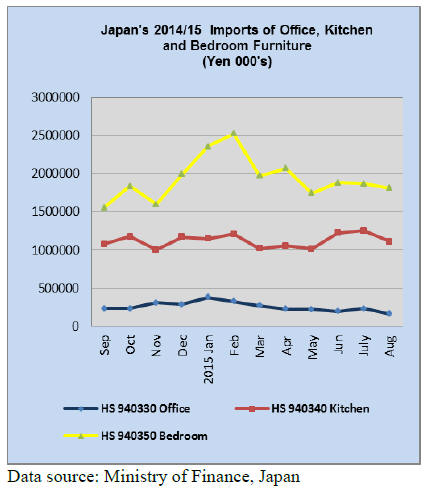
Office furniture imports (HS 940330)
August imports of office furniture fell sharply dropping
26% from July and year on year August 2015 office
furniture imports were down a massive 42%.
The top three suppliers in August were China, Italy (the
new comer), Portugal and Taiwan another new comer to
the top league of suppliers.
Office furniture imports from China were down 24% in
August while imports from Italy tripled. Portugal‘s supply
of office furniture declined in August compared to a
month earlier. Unlike imports of kitchen and bedroom
furniture, SE Asian suppliers do not feature significantly
in the office furniture market in Japan.
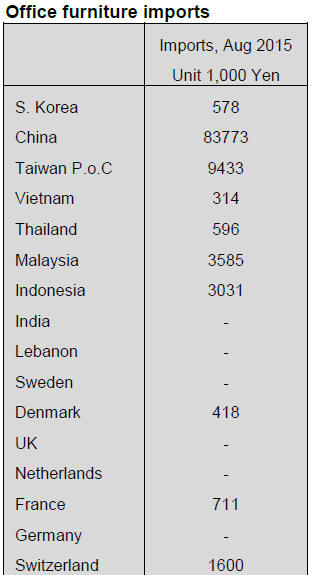
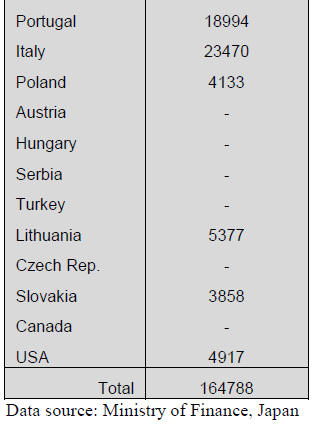
Kitchen furniture imports (HS 940340)
The top three suppliers of kitchen furniture to the Japanese
market (Vietnam. Philippines and China) account for
around 85% of all wooden kitchen furniture imports.
Vietnam is the largest supplier and in August the value of
exports to Japan was only slightly higher than in July.
On the other hand both Philippines and China saw their
share of kitchen furniture shipments to japan decline
compared to levels in July.
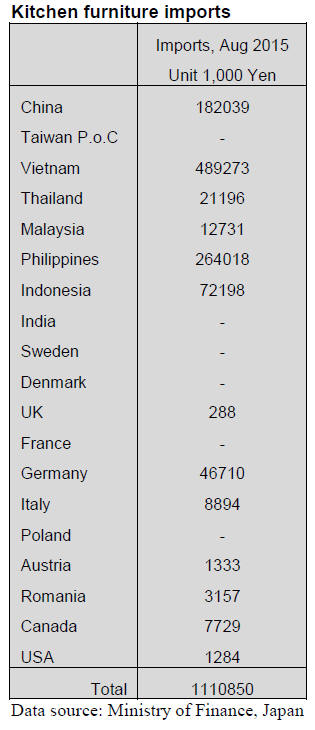
August figures show a 27% rise in imports of kitchen
furniture from Germany in sharp contrast to the 60%
decline for Indonesia. SE Asian suppliers of kitchen
furniture to japan account for 77% of total kitchen
furniture imports
Bedroom furniture imports (HS 940350)
Japan‘s wooden bedroom furniture imports (HS 940350)
in July were disappointing low and the downward trend
continued into August although the pace of decline has
slowed.
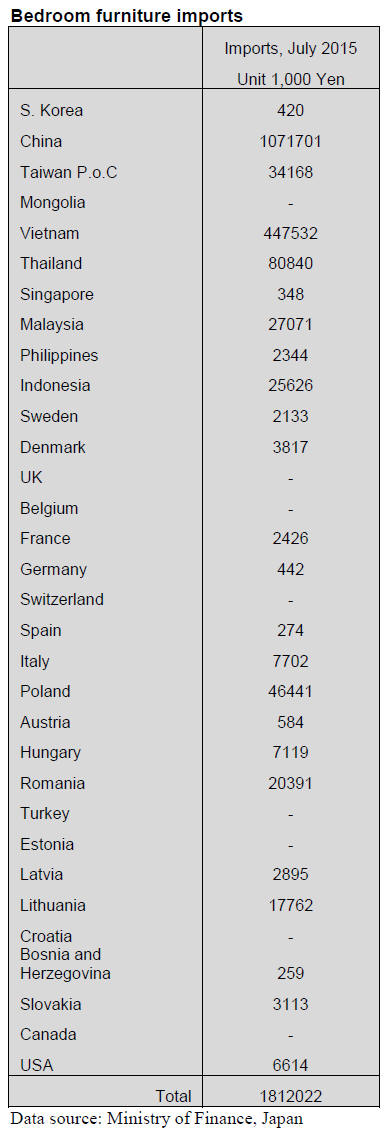
Two countries, China and Vietnam account for around
84% of Japan‘s bedroom furniture imports but, unlike the
situation for office and kitchen furniture, SE Asia
suppliers (buoyed by the huge supply from Vietnam)
enjoyed a 32% share of Japan‘s August bedroom furniture
imports.
Year on year August 2015 imports of bedroom furniture
by Japan rose around 9%.
Trade news from the Japan Lumber Reports (JLR)
For the JLR report please see:
http://www.nmokuzai.
com/modules/general/index.php?id=7
Plywood supply
Domestic production has been curtailed then the volume
of imports declined. The most noticeable change in
imports is Indonesian volume exceeded Malaysian
volume. Total imports were 232,900 cbms first time to
exceed 210,000 cbms after three months.
Malaysian volume has been declining for the last six
months and Indonesian volume surpassed for the first time
in about four years since October 2011. Malaysian volume
in July was 27.7% less than July last year, the lowest since
October 2011. This does not mean demand has shifted to
Indonesia from Malaysia. Seven months total from
Indonesia was 18.2% less than 2014.
Overwhelming share of Malaysian supply is now changing
in supply structure. Decline in Malaysian supply is partly
because of tightened log supply but sluggishness of
Japanese market is another large reason. Supply from
China continues low with seven month total of 390,000
cbms, 18.1% less.
Domestic production in July was 215,400 cbms, 5.5% less
out of which softwood was 199,500 cbms, 6.4% less, the
lowest since August 2014.
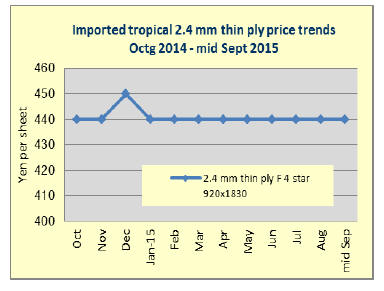 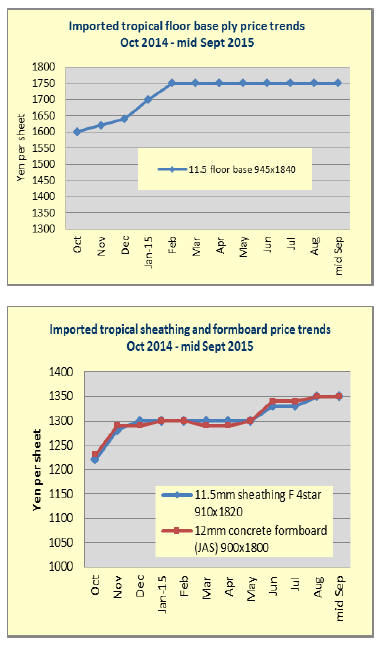
South Sea (tropical) Logs
After Indian buyers made big purchases of 250-300,000
cbms to cover two months demand in July in Sarawak,
they pulled out so supply side was pausing without much
activity. It is said that India will be in monsoon period for
two months so they procured before this season.
Also, China‘s purchases weakened by high log inventories
in China and sluggish market. The suppliers are reducing
harvests in this situation. The Japanese buyers wish to take
this occasion to reduce the export prices.
Since late august Chinese currency, yuan depreciated and
the yen appreciated from 124 yen to the dollar to 120 yen.
Then the Malaysian currency, ringgit dropped to the
lowest since 1998. This increases revenues for suppliers.
At the same time, log supply in Sabah is increasing and
Japanese buyers shift to Sabah for log purchases. This
becomes a good leverage in negotiating with Sarawak log
suppliers.
Present prices of Sarawak meranti regular are US$280-290
per cbm FOB, slightly down from August but still high for
the Japanese plywood manufacturers. In PNG, after China
quiets down, purchase is easier for Japanese buyers but
due to weak yen the cost remains high.
|